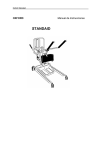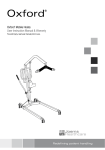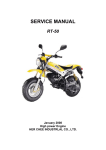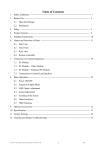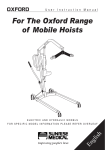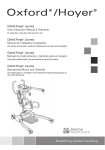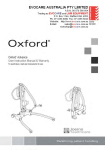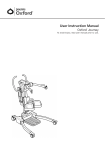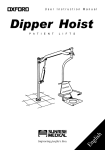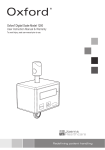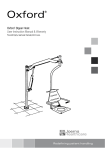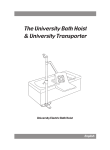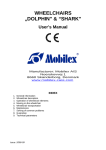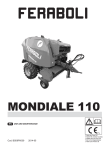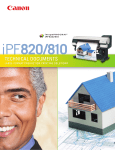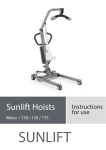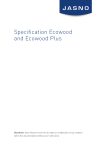Download Oxford Standaid
Transcript
12 12 12 12 12 User Instruction Manual Standaid 140 En gl ish PATIENT STANDING & TRANSFER LIFT Oxford Standaid 140 Contents Introduction .................................................................................. page 2 Oxford Standaid 140 illustration ................................................... page 3 Assembly and commissioning instructions .................................. page 4 Assembly of mast to base illustration ........................................... page 5 Safety precautions ........................................................................ page 7 Rear controls illustration ............................................................... page 8 Operating instructions .................................................................. page 9 Charging instructions ................................................................... page 11 Daily check list .............................................................................. page 12 Maintenance, Inspection & Test .................................................. page 13 Technical Specifications ............................................................... page 15 Slings for use with the Oxford Standaid 140 ................................. page 16 User guide for the Standaid Slings ............................................... page 17 Servicing, Repairs, Inspections & Testing .................................... page 21 1 Oxford Standaid 140 About Your Standaid The Oxford Standaid 140 is fully assembled, load tested and certified before being partially dismantled for packing. The packing consists of a strong, purpose built carton and is used for both export and domestic markets to ensure the safe arrival of the lift. A number of documents are supplied in a wallet packed with each lift and should be kept safely for future reference. Test Certificate User Manual Dealer Guarantee Card Customer Satisfaction Card The TEST CERTIFICATE is an important document and will be required for your insurance records. It is valid for six months and after it has expired the lift should be inspected and serviced for the following six months. Servicing and periodic testing can be carried out by your supplier. Please ensure your lift is included in their maintenance schedule. The Oxford Standaid 140 is suitable for the following CATEGORIES of lift within the working parameters of the lifts specified in the TECHNICAL SPECIFICATIONS. Category A - Wheelchair Category D - Toilet/Shower Chair The Oxford Standaid 140 is suitable for patients in the SITTING and SITTING/RECUMBENT positions. The CE mark The Oxford Standaid 140 carries the CE mark and complies with the following EC directives: Medical Device Directive (93/42/EEC) EMC Directive (89/336/EEC) (Electrics only) Low Voltage Directive (73/23/EEC) (Electrics only) 2 Oxford Standaid 140 THE OXFORD STANDAID 140 3 Oxford Standaid 140 Assembly and Commissioning Instructions Place the carton in a clear working area and open carefully. The carton contains: Main Wheeled Chassis Mast and Boom Assembly Leg Adjusting Handle Wallet Containing Documents Handcontol Battery Charger Battery Pack 1. Remove all the parts from the carton and place on the floor, taking care to protect the finish from damage. SAFETY NOTE: Some of the parts are heavy and will need to be lifted with care. You may need assistance with the heavier assemblies. 2. Apply the brakes on the rear castors of the chassis. 3. Fit the mast assembly to the chassis. The mast is located into the rectangular socket on the top centre of the chassis. SAFETY NOTE: Avoid trapping fingers. Keep fingers away from the end of the mast when inserting into the socket. 4. When the mast is fully engaged with the socket, turn the mast locking knob clockwise until fully tightened. SAFETY NOTE: Full engagement of the mast is indicated by the label on the side of the mast. 5. Remove the screw from the leg adjusting lever located at the rear of the chassis. Fit the leg adjusting handle through the gate on the mast and push the open end over the leg adjusting lever. Align the notch in the handle with the cross pin in the lever. The handle is retained by a screw through the clearance hole in the handle into a threaded hole in the lever. Insert screw and fully tighten. 4 Oxford Standaid 140 EN M A GA ST GE LIN ME E NT ASSEMBLY OF MAST TO BASE 5 Oxford Standaid 140 Assembly and Commissioning Instructions (cont.) 6. Check the legs of the lift open and close satisfactorily. 7. Check the RED emergency stop button located on the Controller is in off (out) position. 8. Fit the handcontrol to the handcontrol socket located at the base of the Power Pack. Important The handcontrol plug is indexed and can only be fitted one way. Do not force, but make sure the plug of the handcontrol is firmly pushed into the socket. 9. Plug the actuator jack plug into the (left socket) actuator socket located at the base of the Power Pack. 10. Push the up and down buttons on the handcontrol and confirm the boom rises and lowers. The lift is now ready for use. 6 Oxford Standaid 140 Safety Precautions Please read and follow the safety precautions listed below. The operation and use of Oxford patient lifts is simple and straightforward. Following these few basic safety precautions will make lifting operations easy and trouble free. ALWAYS plan your lifting operations before commencing. ALWAYS carry out the DAILY CHECK LIST before using the lift. ALWAYS familiarise yourself with the operating control and safety features of a lift before lifting a patient. DO NOT use a sling unless it is recommended for use with the lift. ALWAYS check the sling is suitable for the particular patient and is of the correct size and capacity. NEVER use a sling which is frayed or damaged. ALWAYS fit the sling according to the instructions in the user manual. ALWAYS check the safe working load of the lift is suitable for the weight of the patient. ALWAYS carry out lifting according to the instructions in the user manual. NEVER disconnect or bypass a control or safety feature because it seems easier to operate the lift. NEVER force an operating or safety control. All controls are easy to use and do not require excessive force to operate. If a control is not working easily there will be a reason. Forcing will only strain or damage the lift and may compromise safety. DO NOT lift a patient with the castor brakes on. DO NOT attempt to manoeuvre the lift by pushing on the mast, boom or patient. ALWAYS manoeuvre the lift with the handle provided. ALWAYS lower the patient to the lowest comfortable position before transfers. DO NOT push a loaded lift at speeds which exceed a slow walking pace (3 Kilometres/hour 0.8 metres/second). DO NOT push the lift over uneven or rough ground. particularly if loaded. DO NOT attempt to push or pull a loaded lift over a floor obstruction which the castors are unable to ride over easily. DO NOT bump the lift down steps, loaded or unloaded. DO NOT attempt to negotiate a loaded lift on a slope which exceeds 1:12 (approximately 5 degrees). Sunrise Medical recommend a second helper is present when moving a patient on a slope. 7 Oxford Standaid 140 Emergency Stop Button Detachable Battery Pack EN MA GA ST GE LIN ME E NT Actuator Motor Emergency Raise/Lower Battery Indicator OXFORD STANDAID 140 REAR CONTROLS 8 Hand Control Oxford Standaid 140 Safety Precautions (cont.) DO NOT park a loaded lift on ANY sloping surface. DO NOT use electric lifts in a shower. DO NOT charge an electric lift in a bathroom or shower room. DO NOT lift a patient unless you are trained and competent to do so. YOUR lift is for patient lifting. DO NOT use it, or allow it to be used, for any other purpose. Operating a Standaid 140 1. Leg adjustment. The legs on the Standaid are adjustable for width. The legs can be opened to enable access around armchairs or wheelchairs. For transferring and negotiating narrow doorways and passages the Lift legs should be in the closed position. To achieve the adjustment, the leg adjuster handle, located at the rear of the mast, is moved in towards the mast and then sideways from RIGHT (fully closed) to LEFT (fully open). The adjustment can be carried out with the patient in the lift, but loaded or unloaded the adjustment should be made when the lift is moving. 2. Castors and Braking. The lift has two braked castors which can be applied for parking. When lifting, the castors should be left free and unbraked. The Lift will then be able to move to the centre of gravity of the lifting operation. If the brakes are applied it is the patient that will swing to the centre of gravity and this may prove disconcerting and uncomfortable. 3. Straight line steering. The straight line steering device is fitted to one of the rear castors. This makes steering in a straight line easier to achieve. The device is engaged by simply swinging the U shaped bar over the end of the leg. The bar will automatically engage as you move off. 4. Raising and lowering the boom. The movement of the boom is achieved by a powerful electric actuator which is controlled by a simple handcontrol unit. The handcontrol has two buttons with directional arrows UP and DOWN. The actuator stops automatically at the limit of travel in both directions. The handcontrol plugs into a socket at the base of the Controller. There is a magnetic backing to the handcontrol which allows it to be parked on the mast or boom when not in use. 9 Oxford Standaid 140 5. Emergency Stop. The large, red Emergency Stop Button is located on the Controller and is activated by pressing in. This will cut all power to the Lift and can only be reset by twisting the button anticlockwise and releasing. 6. Emergency Raise/Descent. Emergency raise/descent buttons are provided. These are located underneath the Emergency Stop button. These can be activated by means of inserting a ball point pen tip. This will raise/lower the boom should the handcontrol fail. Caution should be excercised when using this control as there is no automatic cut-out of the actuator when the bottom stop is reached. 7. Batteries. The batteries are protected from deep discharge by a LOW VOLTAGE ALARM. This will sound when the batteries need recharging and the handcontrol is being operated. It will not sound independently of the handcontrol being operated. DO NOT IGNORE THIS WARNING ALARM. Complete the lifting operation and place the lift on charge (see charging instructions). 8. Slings. The selected sling is attached to the spreader bar hooks, each sling is supplied with instructions and they are reproduced in this manual. The instructions should be followed carefully. Use only SUNRISE MEDICAL slings, Standing and Transport range. 10 Oxford Standaid 140 Charging Instructions For The Standaid 140 The batteries are located in the power pack and are charged through two contacts on the base. When the power pack needs charging it is removed from the lift and fitted to a charging unit. Sunrise Medical Ltd recommend an additional power pack is purchased, so that one pack can be on charge at all times. 1. Remove the power pack from the lift. The pack is retained by a simple latch at the top of the pack. Lift the latch and the power pack will be released. 2. Fit the power pack to the charging unit. The location and latching of the power pack to the charger is the same system as used on the lift. 3. Plug the charger mains plug into a suitable mains outlet and switch the mains supply ON. 4. Charging is automatic and will fully charge the batteries over a period of eight to twelve hours. Note: Even if the charger is left plugged in for extended periods it will not allow the batteries to overcharge. 5. To return the lift to service, switch OFF the mains supply and remove the power pack from the charger. Fit the power pack to the lift and make sure the latch holding the pack in place is fully engaged. The charging of Oxford electric lifts is simple and straightforward, but it is important to follow the charging instructions closely. Please pay particular attention to the following points, they will help you avoid problems with discharged batteries. KEEP the batteries fully charged. Place the power pack on charge whenever it is not in use. If it is more convenient to do so, place on charge every night. The charger will not allow the batteries to overcharge. NEVER run the batteries completely flat. As soon as the audible warning sounds, complete the lifting operation in hand and place on charge. NEVER store the power pack for long periods without regular charging throughout the storage period. ALWAYS make sure the mains power to the charger is switched off before connecting or disconnecting the power pack. NEVER leave the power pack plugged in to the charger with the mains power off. ALWAYS check Battery Charge Indicator (LCD) screen. 11 Oxford Standaid 140 Maintenance Schedule For The Standaid 140 All Oxford products are designed for Minimum maintenance, however some safety checks and procedures are required. A schedule of DAILY and tasks are detailed below. Daily checks and a biannual service, inspection and test will ensure a lift is kept in optimum safe working condition. A list of spare parts is available upon request. The LOAD TEST and CERTIFICATION should only be carried out by qualified personnel or an authorised service dealer. Daily Check List Sunrise Medical Ltd strongly recommend the following checks are carried out on a daily basis and before using the hoist. MAKE sure the Lift moves freely on its castors. MAKE sure the legs open and close correctly. OPERATE the handcontrol to confirm the boom raises and lowers satisfactorily. CONFIRM the lift is not giving a low battery alarm when the handcontrol is operated. If the alarm sounds DO NOT use and place on charge immediately. CHECK the operation of the emergency stop button.. MAKE sure the mast is fully engaged and the locking knob is fully tightened. EXAMINE slings for fraying or other damage. DO NOT use any sling with fraying or damage to the suspension straps or tears in the body of the sling. 12 Oxford Standaid 140 Maintenance, Inspection And Test Sunrise Medical Ltd recommend a thorough inspection and test of the Oxford Standaid and lifting accessories, slings etc. is carried out every six months. The examination and test should be conducted according to the recommendations and procedures below. Sunrise Medical Ltd recommend maintenance, inspection and certified testing is carried out by authorised service dealers only. Note: These recommendations are in compliance with the requirements of 1998 No2307 Health and Safety: The Lifting Operations and Lifting Equipment Regulations 1998. This is a UK regulation. Outside the UK please check your local requirements. BOOM: Check the attachment of the boom to the mast. Make sure there is only minimal side movement of the boom and the boom is free to rotate on the boom bearing. Check the actuator mounting. MAST: Check the operation of the mast locking device. Make sure the mast fully engages into the socket. Check the bottom actuator mounting. CROSSMEMBER: Check the function of the Emergency Stop button. Check the operation of the Emergency Descent button. Inspect the handcontrol socket for damage and firm fitting to the chassis. Check the operation of the handcontrol. Check the fuse for correct rating and the fuseholder for firm fitting and possible damage. LEG ADJUSTMENT: Check the leg linkages are secure and the leg adjustment handle is located correctly in the leg adjustment gate. Operate the leg adjusting handle and confirm smooth opening and closing of the legs. Adjust linkages if necessary. LEG PIVOTS: Check the leg pivots are secure and the legs pivot freely. Any stiffness must be investigated. Strip out the leg pivots and lubricate with a light mineral based grease if in any doubt. Make sure there is no excessive play in the leg pivots. CASTORS: Check all castors for firm attachment to the legs. Check for free rotation of the castor and the wheels. Remove any build up of threads, hair or fluff. Lubricate if necessary with a light mineral based grease. Check correct operation of the brakes. ACTUATOR: The actuator should require no maintenance other than checking for correct operation and listening for unusual noise. BATTERIES:. Are located in the Power Pack and should not require maintenance other than regular charging as detailed in the charging instructions. 13 Oxford Standaid 140 CLEANING: Clean with ordinary soap and water and/or any hard surface disinfectant. Harsh chemical cleaners or abrasives should be avoided as these may damage the surface finish of the lift. Avoid wetting any of the electrical parts. LOAD TEST: The load test should be carried out in accordance with the manufacturers test procedures. It is strongly recommended the testing is carried out by an authorised service dealer. CERTIFICATION: An authorised service dealer will issue a test certificate after satisfactory completion of the load test. This certificate will be valid for six months. 14 Oxford Standaid 140 Te c h n i c a l S p e c i f i c a t i o n s Safe Working Load ........................................................................................................ 140kgs Maximum Overall Length ......................................................................................... 1220mm Minimum Overall Length .......................................................................................... 1170mm Maximum Overall Height .......................................................................................... 1625mm Minimum Overall Height .......................................................................................... 1138mm Spreader Bar Max. Height ......................................................................................... 1585mm Spreader Bar Min. Height .......................................................................................... 1090mm Height At Maximum Reach ...................................................................................... 1090mm Reach At Maximum Height ............................................................................................... N/A Reach At Minimum Height ......................................................................................... 240mm Maximum Reach ........................................................................................................... 240mm Turning Radius ............................................................................................................ 1250mm Legs Open - External Width ............................................................................ 1240mm Legs Closed - External Width .............................................................................. 610mm Internal Width ............................................................................. 1065mm Internal Width ............................................................................... 520mm Overall Height Of Legs ................................................................................................ 100mm Ground Clearance ............................................................................................................ 30mm Front Twin Castors ......................................................................................................... 75mm Rear Braked Castors ..................................................................................................... 100mm Weights: Mast & Boom Assembly ........................................................................................ 18.5kgs Base Assembly ............................................................................................................. 30kgs Electrical Specifications Batteries Battery Capacity 2 X 12 volt Rechargeable sealed lead acid type 3.2 Ampere hours Charger Rated Input 230Vac 50/60 Hz Charger Rated Output 27.4/29.0 [email protected] Electric Shock Protection Charger Class II Lift - Internal Power Source Degree Of Shock Protection Charger - Type B Lift - Type B 15 Oxford Standaid 140 Slings For Use With The Oxford Standaid 140 Sunrise Medical Ltd has designed a range of slings to be used with the Oxford Standaid 140. Do not use slings other than those listed below: Oxford Standing Sling Oxford Transport Sling Special requirement slings can be made to customers own specification, consult your dealer for details. When selecting a sling from the Oxford range be sure to assess the suitability of the type of sling for the patient to be lifted. The following guides will assist in the correct selection. 16 DO NOT use any other manufacturers sling with an Oxford lift. DO NOT use an Oxford sling with any other manufacturers lift. Oxford Standaid 140 User Guide For Standaid Slings The Standing sling is an easy fit roll sling, suitable for standing and supporting. It is not a general purpose sling and patients must be assessed for suitability by a qualified person. The Transport sling is an easy fit general purpose sling giving full support to patients. It cannot be used for double amputees, other patients must be assessed for suitability by a qualified person. The Standaid slings are used for the following categories of lift: Category A - Wheelchair Category D - Toilet/Shower chair The Standing and Transport slings are suitable for patients in the SITTING position only. Standing Sling Transport Sling The Standing and Transport slings have been designed for use with the Oxford Standaid 140 and should not be used with any other lift. Additional slings are available to suit individual needs. You are advised to always seek the advice of an authorised dealer before purchasing. Sunrise Medical will be pleased to advise your nearest authorised dealer who will be able to handle all purchasing, training and after sale servicing. DO NOT use any other manufacturers sling with an Oxford lift. DO NOT use an Oxford sling with any other manufacturers lift. 17 Oxford Standaid 140 How To Fit The Standing Sling Fig 1 Place sling down behind patients back between base of shoulder blades and bottom of rib cage. Attach velcro straps around the front of the patient. This strap need not be tight. It is there to hold the sling in position whilst attaching the sling to the Standaid . It may be left off altogether if preferred. Ensure that the patients arms are outside the roll. Fig 2 Position Standaid so that the patients feet fit in the foot trays and knees rest against the knee pad. Initially attach the longer loops of the sling to the white hooks at the end of the Standaid hand grips. The patients hands should be placed on the hand grips. (Once the patient is used to the lift the shorter loops may be used to achieve a more upright position). Then push UP button on handcontrol to raise the patient to the standing position. NOTE: This sling is not a general purpose sling and will not be suitable for some patients. 18 Oxford Standaid 140 How To Fit The Transport Sling Fig 3 Feed the sling down the back of the patient leaving the top of the commode aperture at the base of the spine. Check the roll part of the sling is square across the patients back. Fig 5 Raise the patients leg and feed the leg strap under and up between the legs. Ensure the sling is not twisted or creased under the thigh. Repeat this procedure for the other leg. Attach the loops on the roll parts of the sling to the white hooks at the end of the hand grips. Fig 4 Attach the velcro strap around the chest of the patient. This strap need not be tight. It is there to hold the sling in position whilst attaching the loops to the Standaid. It may be left off altogether if preferred. Ensure patients arms are on the outside of the roll. Fig 6 Without crossing the loops on the leg straps, attach to left and right black knobs on the lifting fork. You would normally use the middle of the three loops. The patient is now ready to be raised from the seat. Once clear of the seat, the patient will be more comfortable if lowered back in to the sitting position. Sunrise Medical recommends slings are checked regularly and before use for fraying or damage. Do not use slings that are worn or damaged. 19 Oxford Standaid 140 Sizing The Standing sling is supplied in only one size. The Transport sling is obtainable in two sizes, Medium and Large. Sized slings are marked with the following colour coded symbols, one of which will be crossed out. Your sling will be the uncrossed size i.e. in the example given Medium (Yellow) MEDIUM (Yellow) LARGE (Green) The straps on the sling are also colour coded. For example, a medium sling will have yellow loops in the positions normally used for a medium patient. SAFE WORKING LOAD OF THE STANDING SLING - 140 kgs SAFE WORKING LOAD OF THE TRANSPORT SLING - 140kgs IMPORTANT NOTE: It is important to take the safe working load of the Lift as the maximum permissible load of any lifting operation. The Standing and Transport slings are designed for use with the Oxford Standaid patient standing aid.. Washing Instructions Wash in a mild soap solution up to 71 degrees centigrade. DO NOT use biological detergents. DO NOT bleach. DRY in a warm room or in the open air. DO NOT place on convector heaters or steam pipes. DO NOT dry in tumble dryers which exceed 120 degrees centigrade. Symbols 71 C Do not exceed 71 degrees centigrade 20 Do not bleach Oxford Standaid 140 Servicing, Repairs, Inspections And Testing Sunrise Medical Ltd has an established network of reputable distributors and dealers who will be pleased to handle all your purchasing, warranty, repair and maintenance enquires. Included with each lift is a prepaid Customer Satisfaction card. Please take the time to fill it in and return it to Sunrise Medical Ltd. Our products are guaranteed for a period of twelve months from the date of manufacture or twelve months from the date of purchase if commissioned by an authorised dealer. We recommend that all of our products are commissioned by your dealer and are supported by them for future servicing. The dealer or distributor operates the warranty programme, so it is important to keep a record of their name address and telephone number so they can be contacted should any problem arise. If you are in doubt where your lift was purchased, Sunrise Medical can trace the supplier if you quote the serial number of the lift. REMEMBER: Contact your distributor for purchases, Warranty, repairs, servicing and annual certified maintenance. Your distributor: 21 Sunrise Medical Limited High Street Wollaston West Midlands DY8 4PS England Tel: +44 1384 44 66 88 Fax: +44 1384 44 66 99 www.sunrisemedical.co.uk 374-10075 Issue 4 03/03

























